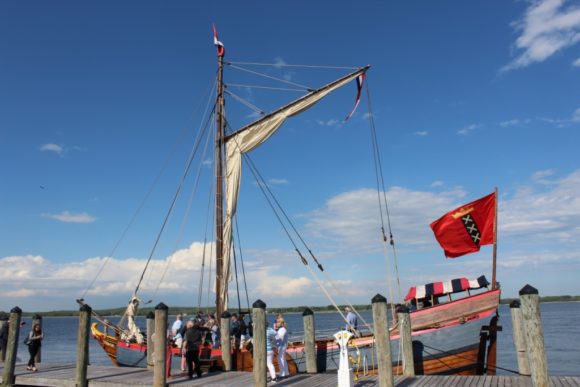
It was “a momentous occasion,” according to Connecticut River Museum Executive Director Chris Dobbs when a group of dignitaries and invited guests gathered to board the re-creation of Adriaen Block’s boat Onrust last Thursday. Dobbs pointed out that it was, “400 years ago — 403 to be precise” since the original Onrust commenced its exploration of the Connecticut River ultimately exploring it upstream to just a little further north than present-day Hartford — a distance of approximately 60 miles from Long Island Sound.

While overwintering (1613-1614) in New York Bay, the Dutch explorer Block’s first ship, the Tyger (Tiger), caught fire and burned to the waterline. Working through the frigid winter, Block built a new ship from the salvaged remnants and named it the Onrust, Dutch for ‘Restless.’
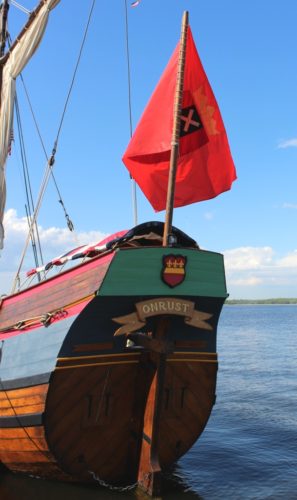 It was the first vessel built by Europeans in New York State and the first yacht built in the New World. In 1614, Block and his crew set off to explore coastal New York, Long Island, Connecticut, and Rhode Island with the intent of developing trade partnerships with Native Americans. During his time on the water, Block became the first known European to travel up the Connecticut River
It was the first vessel built by Europeans in New York State and the first yacht built in the New World. In 1614, Block and his crew set off to explore coastal New York, Long Island, Connecticut, and Rhode Island with the intent of developing trade partnerships with Native Americans. During his time on the water, Block became the first known European to travel up the Connecticut River
The re-created Onrust was launched in 2009 by The Onrust Project, an all-volunteer non-profit out of New York, which built the vessel after painstakingly researching traditional Dutch shipbuilding techniques.
To reach the Saybrook Point Inn at Old Saybrook, Conn., where the guests boarded the ship, the Onrust followed a similar path to the one that Block took in 1614. It departed from Kingston, N.Y., traveled to New York Bay, traversed the treacherous Hell Gate, entered Long Island Sound and sailed to the mouth of the Connecticut River.
While preparations were made to launch, Connecticut River Museum Board Chairman Tom Wilcox told the guests now assembled on board the Onrust, “This is a most auspicious occasion,” and correctly predicted they would have, “a lovely sail.” Despite an earlier threat of rain, the weather cooperated completely with warm temperatures and clear skies.

Another guest on board was Steven Tagliatella, owner of the Saybrook Point Inn, who spoke effusively about the upcoming trip to the Connecticut River Museum describing the Onrust as “a spectacular sight.” He also took the opportunity to mention the new tourism coalition he has formed to promote tourism in the state, noting that the Onrust offers “a wonderful opportunity” for tourism.
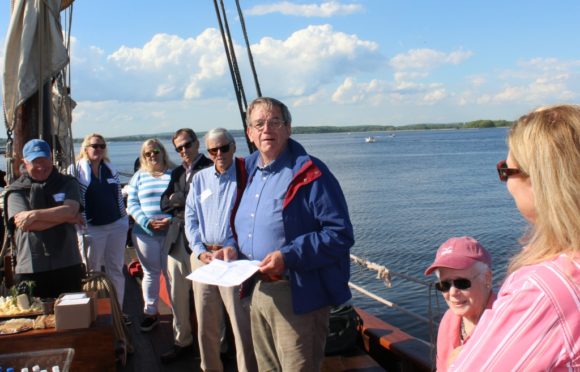
Walter Woodward, Connecticut’s State Historian, really spoke for everyone aboard when he said, “To be on this boat on this day is so exciting,” but then asked the guests to take themselves back in time to the spring of 1614 when Block brought the boat he had built the previous winter and named Onrust – Restless – to the mouth of the river the natives call Quinitticut. Woodward declared that Block, “was as restless as his little vessel,” explaining, “The 47-year-old trader-explorer was anxious to make up the losses he had experienced the previous winter, when his ship the Tyger had accidentally caught fire.”
Woodward pursued the theme of ‘restlessness’ as he continued, saying, “Then as now, the word restless had many meanings … A generation of restless Europeans … both Dutch and English would come to this river, first in search of trade with the indigenous people, and soon after, in the quest for their land and resources.”
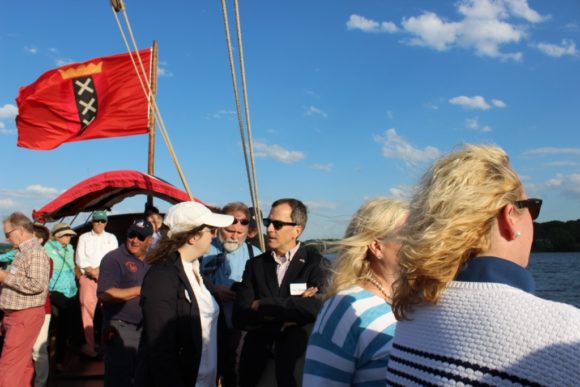
Woodward added, “Some were restless too in a godly way – troubled in mind and spirit, seeking a place to serve God as their consciences demanded.”
He also noted that, “For those already here, the arrival of the Onrust heralded a new native restlessness – first, as the indigenous people jostled with each other for control of the distribution of European trade goods … and later to fight the efforts of these insurgents to drive them from their homes.”
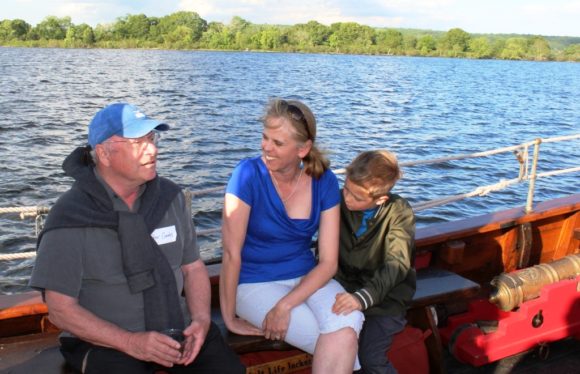
Keeping to his theme, Woodward ended with the words, “I know you are restless to get underway, so let me conclude by saying it is a privilege to be here today to mark the moment in time, when Adriaen Block and his Onrust entered the river he named Fresh River, and a world-transforming era of restless change began.”
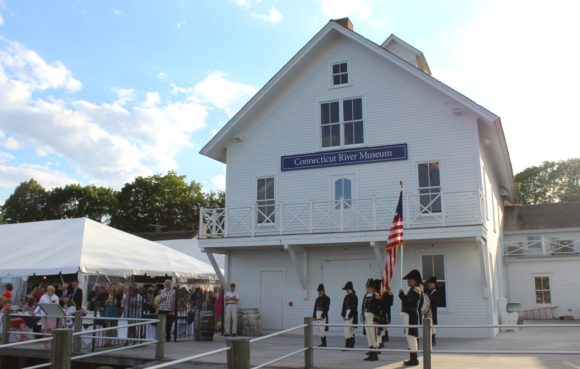
Before introducing the next speaker, Dobbs noted, “The amount of research to build this vessel was amazing,” and also that it had taken, “Around 250 people to build the Onrust.” He explained that the Onrust will be a floating exhibit at the Museum through early October, open for dockside tours, school and Scout programs, along with public cruises and charters.

Dobbs then presented Emily Boucher, who brought a message from Senator Chris Murphy, which she read aloud to the guests on the Onrust. In the message, Murphy expressed the wish that he could join everyone on the trip, and noted he was pleased with the financial assistance the state had given the Museum which, “was going to allow it [the Museum] to not float away.”
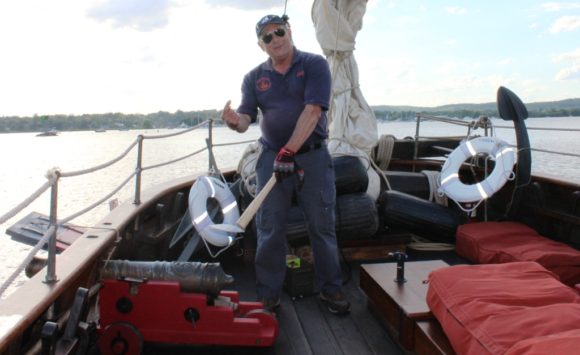
Finally the Onrust departed from Saybrook Point inn and sailed serenely up the Connecticut River offering spectacular views in all directions. As the three-man crew prepared for arrival at the Museum during the first hour of the popular RiverFare event, one crew member fired a celebratory cannon. Meanwhile, Essex’s very own Sailing Masters of 1812 provided a cheery, musical fanfare as the historic vessel approached the Museum’s dock.
It was indeed a wonderful and “momentous” voyage!
For more information on the Connecticut River Museum and the Onrust, visit the Museum’s website. The Museum extends special thanks to Saybrook Point Inn, Marina & Spa, Essex Meadows, the Sailing Masters of 1812, and The Onrust Project for their efforts in arranging the vessel’s arrival.
The Connecticut River Museum is located on the Essex waterfront at 67 Main Street in Essex and is open daily from 10 a.m. to 5 p.m. The Museum, located in the historic Steamboat Dock building, offers exhibits and programs about the history and environment of the Connecticut River. For a full listing of Museum programs or to buy tickets for the Onrust, RiverFare, and many other events go to www.ctrivermuseum.org or call 860-767-8269.
this is the story of the beautiful boat we ran into this past week on the river. my heart is with the indigenous people of america who innocently welcomed the italian, dutch , french and english explorers, only to have their lands stolen. but life is set up for the strong to succeed. and one must admit that the gritty men who sailed and rebuilt the original vessel in the winter cold, after the original boat was burned to the waterline, were certainly a strong force in the new world. at any rate, this boat , an amazing work of art and craftsmanship, a real beauty, will no doubt inspire many new positive and truthful interpretations of our history. rob camp fuoco, sharing nature non profit, burlington, ct